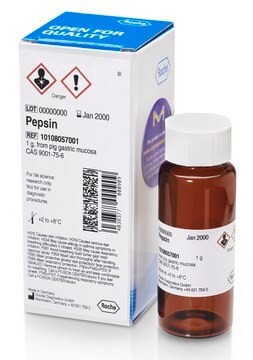516360
Pepsin, Porcine Stomach Mucosa
Catalyzes the hydrolysis of aminoacyl-proline to an amino acid and proline. Inhibitors include aliphatic alcohols, pepstatin A, and pH 6.0.
Synonym(s):
Pepsin, Porcine Stomach Mucosa
Sign Into View Organizational & Contract Pricing
All Photos(1)
About This Item
CAS Number:
MDL number:
UNSPSC Code:
12352202
NACRES:
NA.25
Recommended Products
Quality Level
form
lyophilized
specific activity
≥2000 units/mg protein
manufacturer/tradename
Calbiochem®
storage condition
OK to freeze
desiccated
solubility
10 mM HCl: 0.5 mg/mL
shipped in
ambient
storage temp.
−20°C
Related Categories
General description
Native pepsin from porcine stomach mucosa. Active under acidic conditions. Catalyzes the hydrolysis of aminoacyl-proline to an amino acid and proline. Inhibitors include aliphatic alcohols, pepstatin A, and pH >6.0. Has an optimal pH of 2.0-4.0.
Native pepsin from porcine stomach mucosa. Secreted by the mucosal lining of the stomach. Active under acidic conditions. Catalyzes the hydrolysis of aminoacyl-proline to an amino acid and proline. Inhibitors include aliphatic alcohols, pepstatin A, and pH >6.0.
Warning
Toxicity: Harmful (C)
Unit Definition
One unit is defined as the amount of enzyme that will digest hemoglobin substrates to TCA-soluble products, measured as a change in absorbance at 280 nm of 0.001 per min at 37°C, pH 2.0.
Reconstitution
Following reconstitution, aliquot and freeze (-20°C). Stock solutions are stable for up to 6 months at -20°C.
Other Notes
Bergmeyer, H.V. 1984. Methods of Enzymatic Analysis (3rd ed., vol. 5) p. 232, Academic Press, New York.
Legal Information
CALBIOCHEM is a registered trademark of Merck KGaA, Darmstadt, Germany
Signal Word
Danger
Hazard Statements
Precautionary Statements
Hazard Classifications
Eye Irrit. 2 - Resp. Sens. 1 - Skin Irrit. 2 - STOT SE 3
Target Organs
Respiratory system
Storage Class Code
11 - Combustible Solids
WGK
WGK 1
Flash Point(F)
Not applicable
Flash Point(C)
Not applicable
Certificates of Analysis (COA)
Search for Certificates of Analysis (COA) by entering the products Lot/Batch Number. Lot and Batch Numbers can be found on a product’s label following the words ‘Lot’ or ‘Batch’.
Already Own This Product?
Find documentation for the products that you have recently purchased in the Document Library.
Customers Also Viewed
Our team of scientists has experience in all areas of research including Life Science, Material Science, Chemical Synthesis, Chromatography, Analytical and many others.
Contact Technical Service







